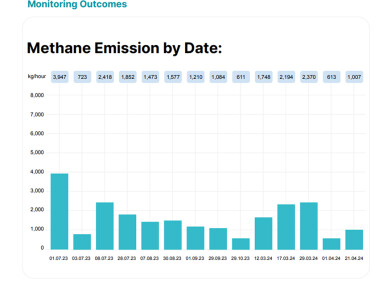Industrial emissions
What the end of coal in the UK actually means for carbon emissions
Sep 11 2024
Britain has reached a pivotal moment in its energy transformation. After over 140 years of coal-powered dominance, the UK is preparing to close its last coal plants. This move symbolizes the end of an era for the UK’s energy history, but the broader implications for carbon emissions are more complex than they might first appear.
Coal has been the driving force behind Britain’s industrial might since the Industrial Revolution. The world’s first coal-fired power station ignited in London in 1882, paving the way for a century shaped by fossil fuels. By 1990, coal was responsible for an astounding 80% of the country’s electricity generation. Yet, as the toll of air pollution, carbon emissions, and climate change became clearer, the cost of burning coal grew unsustainable.
Fast forward to the present, and coal's role in Britain's energy supply has nearly vanished. By 2022, it made up just 1% of electricity generation, overtaken by more efficient sources like wind, solar, and natural gas. The end of coal-fired electricity generation in the UK signals a reduction in the most carbon-intensive form of power, but that doesn’t automatically equate to a steep drop in overall carbon emissions. Natural gas, another fossil fuel, remains a critical component of the UK’s energy mix, accounting for 40% of electricity generation in 2022. Oil and other fossil fuels, while smaller, still contributed about 3% to the mix. This ongoing reliance on fossil fuels complicates the narrative of a fully decarbonized grid.
Despite this significant progress, there has been controversy over plans to open a new coking coal mine in Cumbria. The proposed Woodhouse Colliery, approved in late 2022, is intended to produce coking coal for steel production—a critical material for the industry, as steelmaking currently lacks fully scalable green alternatives. Supporters argue the mine will reduce reliance on imported coal and boost local employment, but critics see it as a contradiction to the UK’s net-zero ambitions. Environmental groups have strongly opposed the project, calling for the steel industry to accelerate its transition to cleaner technologies, like hydrogen-based methods, instead of deepening reliance on coal.
One of the most symbolic moments in Britain’s coal decline is the forthcoming closure of the Ratcliffe-on-Soar power station, one of the country’s last coal-fired power plants. Built in the 1960s, Ratcliffe once had the capacity to power two million homes. For decades, its towering steel boilers burned coal at over 1,000 degrees Celsius, feeding the country's seemingly insatiable demand for electricity. Now, Ratcliffe, like the few remaining coal plants, is being phased out as part of the government's push for a cleaner energy grid by 2030. But while coal’s end represents a step forward, the continuing reliance on gas and oil dampens the potential for sharp reductions in carbon emissions.
The decline of coal is a story made possible, in part, by the extraordinary rise of renewable energy. Wind and solar power, once considered futuristic, now form a growing portion of the UK’s energy grid. In 2022, wind and solar contributed over 32% of Britain’s electricity, while bioenergy and nuclear added significantly to the mix. Yet, despite the growth of renewables, the UK's reliance on natural gas means that a significant portion of its power generation still results in carbon emissions.
Recent years have seen remarkable progress, but this has not led to a fully decarbonized energy grid. The summer of 2023 was Britain’s "greenest" season on record, with the lowest carbon intensity ever recorded for the electricity grid. For the first time, renewable sources like wind and solar surpassed gas in generating electricity, marking a pivotal moment. Yet, while the carbon intensity of the grid—the amount of COâ‚‚ emitted per unit of electricity—has fallen, this doesn’t mean the UK is emitting less carbon overall.
In fact, lower carbon intensity doesn’t always equate to lower total emissions. When energy demand rises, as seen in recent years, overall emissions can still increase, even if the fuel mix becomes cleaner. In 2023, despite the fall in carbon intensity, the UK’s total carbon emissions from electricity generation were higher than in previous years, driven by rising electricity demand from sectors such as electric vehicles and the electrification of heating. This illustrates the complex balance between improving the carbon intensity of the energy grid and controlling overall emissions as the country transitions to renewable energy.
The path to a fully decarbonized power grid by 2030 is not without its challenges. Growing electricity demand, driven by the electrification of transportation and heating, is set to more than double by 2050. Electric vehicles and heat pumps will replace traditional cars and gas heating systems, placing immense pressure on the grid. Moreover, the UK remains heavily reliant on natural gas, which continues to play a significant role in balancing energy supply when renewables fall short.
The government is also fast-tracking efforts to expand wind and solar capacity. Recent auctions have secured contracts for enough renewable projects to power 11 million homes, though critics argue even more aggressive expansion is essential to meet future demands. However, even with this expansion, fossil fuels remain an essential part of the UK’s energy landscape, as evidenced by the dominant role of natural gas and the ongoing use of oil.
As Britain prepares to switch off its last coal-powered stations, it is clear that the end of coal, while significant, is not the final word on carbon emissions. The shift to renewables is undoubtedly a positive step, but fossil fuels, especially natural gas, will remain integral to the country’s energy strategy for the foreseeable future. The government's decision to phase out coal marks an important step, but the ongoing reliance on gas and oil illustrates the challenges of achieving a fully sustainable energy mix and meeting ambitious carbon reduction targets.
Digital Edition
AET 28.4 Oct/Nov 2024
November 2024
Gas Detection - Go from lagging to leading: why investment in gas detection makes sense Air Monitoring - Swirl and vortex meters will aid green hydrogen production - Beyond the Stack: Emi...
View all digital editions
Events
Jan 12 2025 Abu Dhabi, UAE
Jan 14 2025 Abu Dhabi, UAE
Jan 20 2025 San Diego, CA, USA
Carrefour des Gestions Locales de L'eau
Jan 22 2025 Rennes, France
Safety, Health & Wellbeing LIVE
Jan 22 2025 Manchester, UK



















